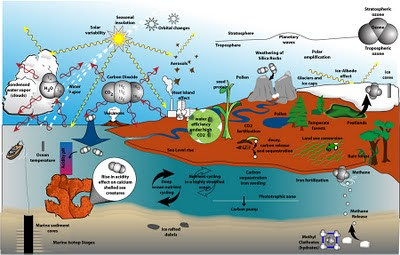 I just finished reading Kopp et al's "Probablistic assessment of sea level during the last interglacial stage" and the excellent News and Views summary by Clark and Huybers. Both articles appeared in the 17 Dec. 09 issue of Nature. The illustration on the left is my greatly simplified analogy of Kopp et al's effort to assess how the redistribution of mass from icesheets as water during the Eemian affects proxy measurements of sea level. Just as pillows of ice at each end of a hammock would change the hammock's shape, so too would icesheets and their loss affect the shape of the global ocean basin. If "hammock earth" becomes a usable term, I expect full credit or ridicule for coining it.
I just finished reading Kopp et al's "Probablistic assessment of sea level during the last interglacial stage" and the excellent News and Views summary by Clark and Huybers. Both articles appeared in the 17 Dec. 09 issue of Nature. The illustration on the left is my greatly simplified analogy of Kopp et al's effort to assess how the redistribution of mass from icesheets as water during the Eemian affects proxy measurements of sea level. Just as pillows of ice at each end of a hammock would change the hammock's shape, so too would icesheets and their loss affect the shape of the global ocean basin. If "hammock earth" becomes a usable term, I expect full credit or ridicule for coining it.Below is a summary of their work, comparing their assessment of sea level to today's. Both articles compared the warmer Eemian temperatures to comparable temperature increases expected from current and expected increases of greenhouse gases. Missing from my diagram is a clarification that sea levels rose at perhaps 65-90 cm per century to the estimated 6-9 meters above current sea level.

(update 5/6/10: revised sketch)
The warmer Eemian climate is linked to greater northern hemisphere insolation as a result of an orbit with greater eccentricity and precession that placed the northern hemisphere solstice close to perihelion. Below, I'm comparing Earth's orbit at the Eemian with Earth's current orbit. These diagrams are for illustration; they are not to scale. I created them using my orbit viewer.
A potential sea level rise of up to 9 meters, suggested by Kopp et al, is disturbing, especially because the author's don't rule out periods of a higher rate of change that the 62-90 cm per century. For me, the observation that CO2 levels didn't rise beyond the Holocene's pre-industrial levels is intriguing. CO2 and methane from a warming biosphere is part of a worst case global warming scenario. I wonder if the Eemian shows that we have a 2-4 C grace period before this feedback kicks in.
jg
















